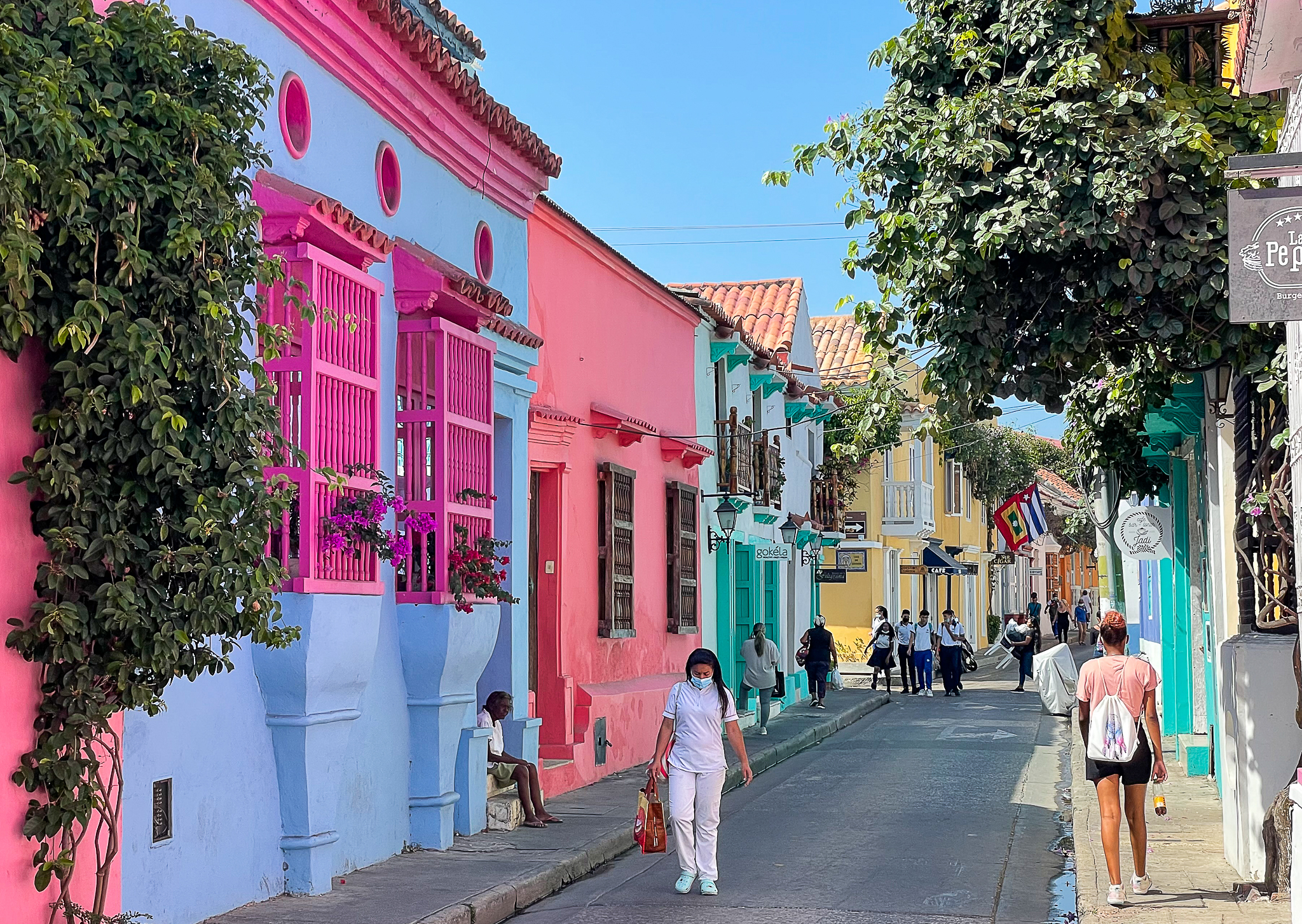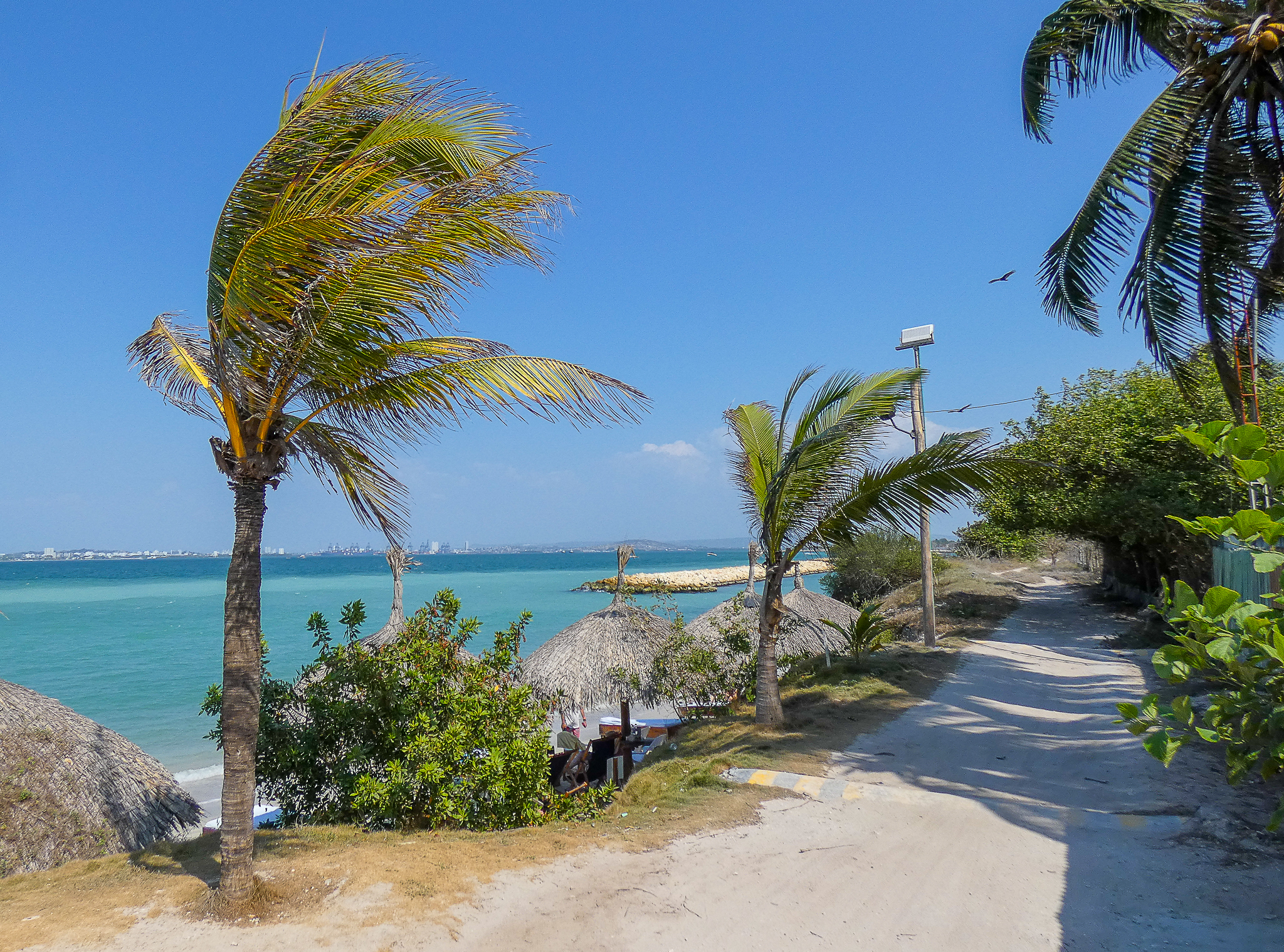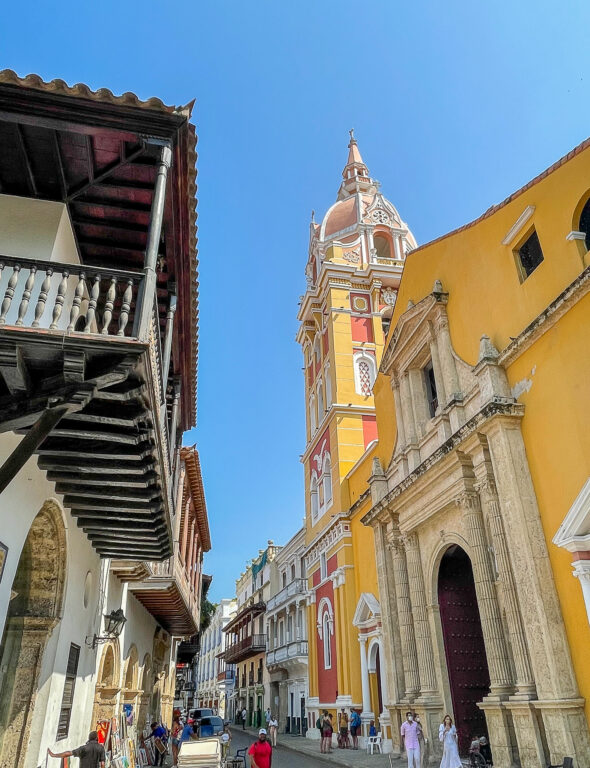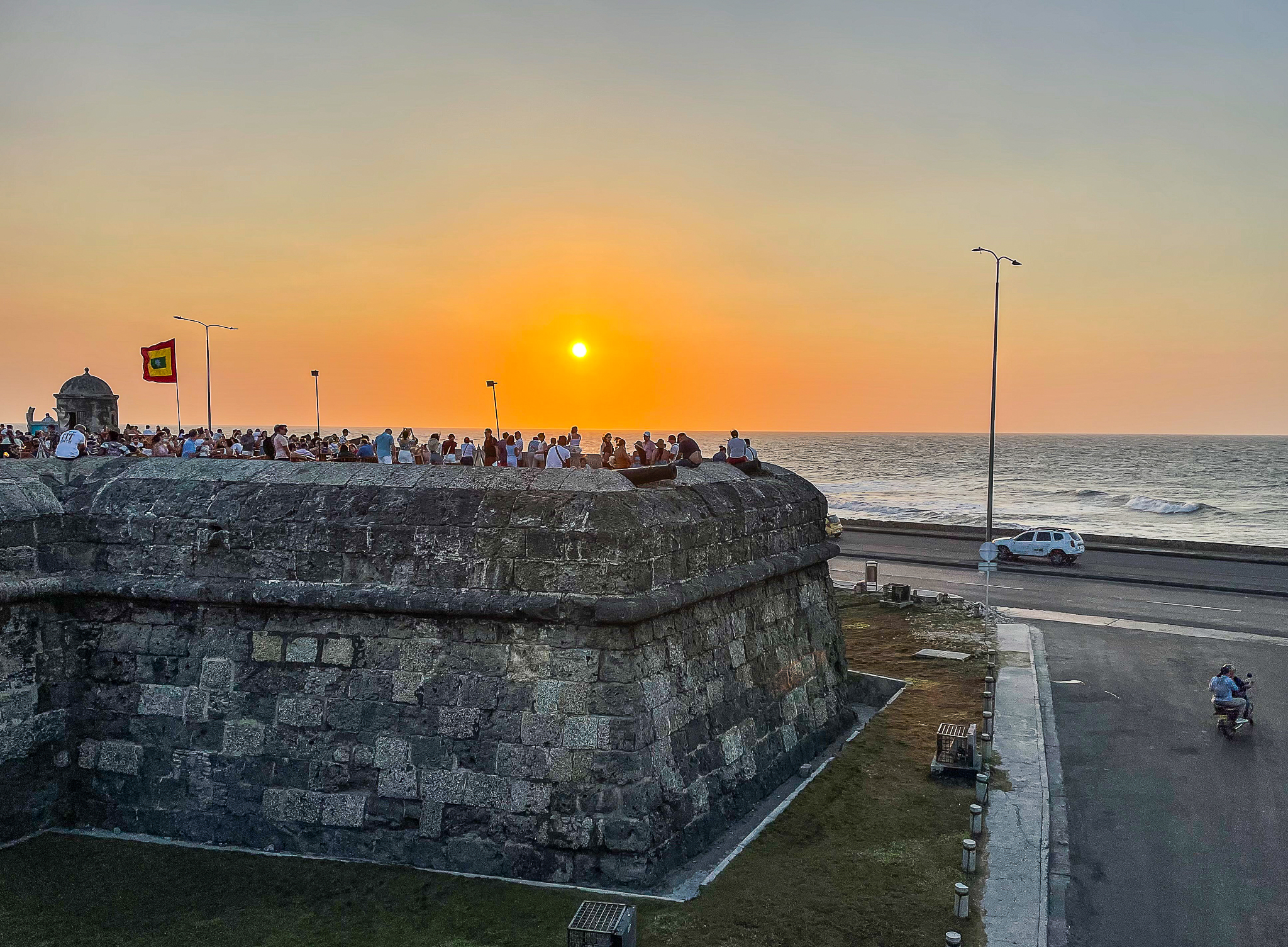Cartagena may be primarily a holiday destination, but those who look beneath the surface will find a fascinating city of culture and history, worthy of even the most demanding travelers.

Story and photos by Libor Pospisil
The flight from the U.S. to Cartagena lasted only three hours, but those were excruciating hours for me. Confined between chattering snowbirds on the one side and excited youngsters on the other — they were headed for a bachelor or a birthday party — I had difficulty concentrating on my novel by Gabriel García Márquez. Who could blame my fellow passengers for going to Cartagena, though? It is the second oldest Spanish outpost in South America and the most picturesque city in Colombia. Its center is covered with a web of narrow, colorful streets and lively plazas. It is protected by iconic defensive walls, which are occasionally whipped by sea waves from across the road. The Caribbean is pleasant to swim in and the locals revel in their luck: “Here, you got only two seasons — summer and hot.” Despite the year-round high temperatures and the seemingly indestructible blue skies, the Caribbean coast of Colombia does have its climatic quirks. Tropical downpours come during rainy seasons, and if you meet a visitor not fond of Cartagena, chances are the extreme humidity was the deal-breaker.

A typical itinerary for Cartagena has visitors staying in the old town or in Bocagrande, the neighborhood of high-rise hotels along the city beach. They roam the streets during the day and frequent bars in the evening. For a glimpse of a seaside tropical paradise, they may go on a boat trip to Playa Blanca or Islas de Rosario — sometimes for a few days. A popular excursion inland takes visitors to the small El Totumo volcano, where they may jump into a mud bath. While Cartagena is primarily a holiday destination, those who look beneath the surface will find a fascinating city of culture and history, worthy of even the most demanding explorers.

Colorful Cartagena
I made my way through Torre del Reloj (The Clock Tower), the grandest entrance into the old town. It was immediately clear that the ubiquitous social media pictures of Cartagena are not artificially enhanced. The colors are as vivid in reality as in people’s holiday memories. And there are a lot of colors and color matches to see on the façades, from snow white combined with orange to azure blue and purple. Every structure is colorful and baroquely decorated; the cathedral, churches, convents, houses, museums, theaters, and universities.
The visual feast of the old town is the result of Cartagena’s half-a-millennia-long history. The city was founded by the Spanish conquistador Don Pedro de Heredia in 1533 — on June 1, 1533, to be more precise. The date is important because it gives a convenient excuse to organize the city’s birthday celebrations every year, filled with concerts and parties.
Cartagena is not just a relic of the past. New art keeps popping up. Historical sculptures find new companions, such as La Gorda Gertrudis in Plaza Santo Domingo. It depicts a reclining, corpulent (gorda) lady that has become a surprisingly popular picture spot in the city. The figure was created by Fernando Botero, the most famous Colombian sculptor. He donated it to Cartagena in 2000. La Gorda is made in his signature style Boterismo, which exaggerates body proportions in a uniquely endearing way.

The houses of Cartagena are not stale either. Some have wooden balconies; others are embraced by branches of tropical plants. In Getsemaní, the walled neighborhood adjacent to the old town, the façades became canvases for local artists, who have created paintings on them, such as plants, butterflies, political slogans, and faces. Among the faces, I could recognize one of a happy gentleman with a round face, short hair, and a proud mustache. It was none other than Gabriel García Márquez, my reading companion from the flight to Cartagena.

Festive Cartagena
Plazas, restaurants, and coffee shops abound with chatty and relaxed crowds, thanks not only to my fellow visitors from the north, often recognizable with their new straw hats, but also because of locals and visitors from other parts of Colombia. The city somehow oozes a cheerful mood, only partly explicable through the weather. The music floats from under the palm trees around sunset and the intensity of the sounds increases as party buses cruise along. Bars fill with enthusiastic salsa dancers, and, unlike certain parts of Europe, dancing skills are a sign of masculinity in Colombia.
Finding a dinner place with extraordinary food could not be easier in Cartagena. Local favorites include arepas — circular flatbreads made of maize, filled with anything from eggs to meat. For those who like seafood, there is cazuelo de mariscos (a pot of seafood). This soup looked murky, prompting me to question whether there was anything in it. But as soon as I started eating, the bowl turned into an ocean of shrimps, clams, and fish. It was hard for one person to finish. The cazuelo was worth finishing, however, both for its taste and for its reported boost to one’s vitality. As Colombians would add with a grin: “Vitality in all respects.”

Heroic Cartagena
What makes Cartagena Cartagena are the almost intact walls, even if they were not built for aesthetic reasons. Since its founding, the city was a shipping hub and storage center for precious metals en route to Spain. That was too strong of a draw for the many French and English pirates of the Caribbean, Francis Drake among them. They raided Cartagena several times until the Spanish lost patience and put up those strong walls, with bastions and turrets.
The walls faced their harshest test in 1815 when the Spanish launched a brutal siege of Cartagena during the Colombian war for independence. The perseverance shown by the city at the time was rewarded by Simón Bolívar himself, who began to call Cartagena La Heroica (The Heroic One), an epitaph that adorns several city monuments.
Today, it is still possible to run up the stairs to the top of the walls at many spots around the old town. The most popular side is the Caribbean one, especially in the evening, when crowds on the wall take in the view of the sun setting over the water. When I briefly turned my back on the sea, there was another scenery — the last rays of the sunlight emphasizing, for one fleeting moment, the colors of Cartagena’s houses, towers, and church domes.
Gloomy and Happy Cartagena
The museums of the old town present Cartagena as a unique blend of three cultures — indigenous, Spanish, and African. One of the museums, appropriately housed in a temporary space in a bank, showcases exquisite gold artifacts of indigenous cultures from various parts of the country. Gold and Colombia are inseparable, since El Dorado, a fabled city of gold that attracted gold-obsessed conquistadores, was supposed to lie somewhere high in the Andes mountains of Columbia.

Another museum occupies the most richly decorated structure on Plaza de Bolívar. Unfortunately, it is called Palacio de la Inquisición, and true to its name, it features exhibits about torture and book banning, only partly balanced out by the brighter side of the city’s history. A few steps away, Museo de San Pedro Claver in the eponymous monastery deals with slavery. Pedro Claver, a 17th-century priest and a patron of Colombia dedicated his life to tending to enslaved Africans brought to Cartagena. His biography may have been a straightforward story in the past, but it has sparked more nuanced assessments in recent years — namely, whether he could have used his status to voice outright opposition to slavery. Away from the halls that raise important moral questions, the museum contains beautiful pieces of Afro-Caribbean art.
Not all Africans arriving in Cartagena ended up in servitude forever. Some managed to escape their fate and walk long distances to remote areas, where they founded their own settlements known as palenques. Those places offered a life of freedom, even if under constant attacks from the colonial administration. The most famous African who had fled to liberty was Domingo Benkos Biohó, called King Benkos. Unfortunately, the Spanish eventually captured and executed him, but his followers went on to build San Basilio de Palenque, the only palenque that has survived to this day. Located about thirty miles (fifty kilometers) away from Cartagena, it has a bust of Benkos in its plaza, and the inhabitants still preserve vestiges of their ancestral African culture and language. San Basilio de Palenque was placed on UNESCO’s cultural heritage list, leading tour operators to offer a day trip there from Cartagena.
The third symbol of Cartagena, after the colorful façades and the walls, actually comes from the palenques. It is the iconic colorful dress, worn by the ladies that carry fruit baskets through the streets of Cartagena. They are called palenqueras, after the women who once traveled from those settlements to the city market and sold fresh produce. Today, the ladies showcase those vividly colored dresses and offer visitors the opportunity to be photographed with them, thus making palenque culture world-famous.
Some visitors may feel a curious disconnect between the gloomy history of Cartagena told by its museums and the city’s happy life — living as if nothing had ever happened. It is not just that Colombians seem content. They confirm it in surveys, in which they out-rank every other nation when asked whether they “feel personally happy.“ And within Colombia, the people on the coast — costeños — are considered the most joyful and carefree of the country’s population, even if that is not always meant as a compliment from other Colombians.

Cartagena Outside the Walls
The coastal flatland of Cartagena ends just behind the Getsemaní district. The first hill is completely occupied by Castillo de San Felipe, the best-preserved Spanish fortress in South America. A little farther, where guidebooks recommend traveling only by taxi, there rises an even higher hill, with the colonial-style Convento de la Popa at its peak. From the convent, I had Cartagena in the palm of my hand — the high-rise hotels, the old town, and the neighborhoods under the corrugated metal plates. While Castillo de San Felipe has long lines of visitors, the convent is far enough from the downtown to be enjoyed in solitude.
I wished to walk through a bustling Colombian place in Cartagena where only a few fellow passengers from the plane usually venture. I, therefore, went to the sprawling Mercado Bazurto. Some more sensitive visitors, who ended up getting lost in the narrow passageways of this market, reported a culture shock because of its rawness. For locals, it is their go-to mall for cheaply priced meals, meat, fish, t-shirts, household items, and everything in between. In the middle of the market, I found restaurant Ceci, where I joined the patrons for corriente, a meal of the day with soup, rice, chickpeas, and meat.
After the sightseeing, I gave in and wanted to see a beach outside the city too. But only briefly. Fortunately, there was a way — a half-day boat trip to the island Tierra Bomba, just across the strait from Bocagrande.

Magical and Realistic Cartagena
The paintings of Gabriel García Márquez — or Gabo, as he is known in Colombia — did not appear on the walls of Cartagena by accident. In 1948 at the age of twenty, he moved to the city to study law, as his father insisted. But Gabo was eager to work as a journalist, so he abandoned the university fairly quickly and began writing for the local newspaper, El Universal. He did not stay there for long. After a few months, he left Cartagena to live in various places in Colombia, the Americas, and Europe. Then, in 1967, his life changed when he published the novel One Hundred Years of Solitude, which earned him the Nobel Prize for Literature. Yet the globe-trotting novelist kept returning to Cartagena, to visit his family and to build a house there. The construction of the house did not mean Gabo intended to live in the city again; it was only a shelter for several weeks a year. Although the house still stands in the old town, it serves merely as a residential building because, for some curious reason, there is no museum in Cartagena dedicated to its most famous resident.

Gabo did not have a sentimental view of Cartagena. The city provided him with a backdrop for his novel Love in the Time of Cholera, which describes a place with “slave quarters,” “broken roofs,” and “decay over the years.” The novel revolves around a rigid society where family background made it impossible to turn romance into marriage. Despite all that, if Gabo had a home, it was Cartagena. After he passed away in 2014 in Mexico City, where he lived at the time, his ashes were brought to Cartagena and placed inside a pedestal with his bust, created for that occasion. As the ultimate contradiction, the memorial for the novelist can be found in Claustro de la Merced, which is a courtyard of the very university where Gabo quit to pursue journalism and writing. I tried to see the bust for myself, but the building was under construction. Luckily, the guard allowed me to at least have a peek through the entrance door. There, in the distance, I could see the bust, which portrayed the writer again as a smiling, friendly gentleman — happy to be in the city he never wanted to live in, and never could leave for good.
Cheerful Cartagena
The cheerful mood of Cartagena is best conveyed not with words, even words of a Nobelist, but with a song. I wish I could play it for you. Performed by Colombian pop singer Carlos Vives, the song La Fantástica recounts the history of Cartagena, with tambora, accordion, and gaita (flute) creating the enthusiastic, dance tune in the background. Not many cultures are able to produce music that transforms gloomy themes into a cheerful melody. Colombia, and especially Cartagena can. But then, the sea on the horizon, the blue skies above, and all the colors around make it easier to see the positive side of life.
IF YOU GO
Where to stay in Cartagena: the old town, Getsemaní, or the hotel neighborhood of Bocagrande are convenient options.
Boat trips from Cartagena: Tierra Bomba (half a day), Playa Blanca, or Islas del Rosario (a full day or longer) all leave from Bocagrande.
Short tours inland: El Totumo Volcano for a mud bath, San Basilio de Palenque for the palenque culture — just check with the local tour companies.
Museums and sites in Cartagena:
- The cathedral and Plaza San Domingo
- The walls and Castillo de San Felipe de Barajas https://compraenlinea.fortificacionescartagena.com.co/home
- Convento Santa Cruz de la Popa https://santuariolapopa.com/
- Museum of Gold — Museo del Oro Zenú https://www.banrepcultural.org/cartagena/museo-del-oro-zenu
- Palacio de la Inquisición — Museo Histórico de Cartagena de Indias https://www.muhca.gov.co/
- Santuario Museo San Pedro Claver https://sanpedroclaver.co/sobre-el-museo/
I made several long trips from Cartagena to places in the Caribbean region of Colombia:
An earlier version of this story appears on Travel Examiner, where you can view dozens of award-winning national and international travel destination articles. Visit here: https://travelexaminer.com/
